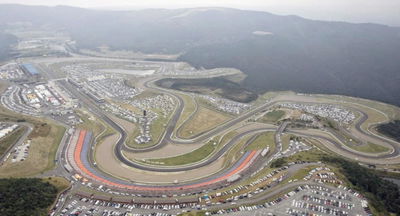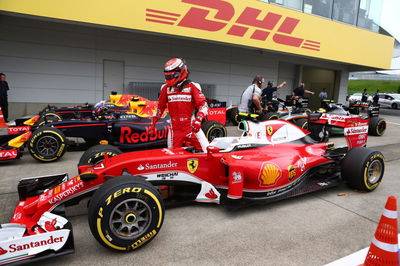Paradise & Picasso: The strange tale of Japan's lost 'Autopian' GP

By Ollie BarstowFollow @OllieBarstow on Twitter
You only have to watch Dragons' Den to appreciate that good ideas often just need money to flourish. If the proposal is thought-provoking, the limitations are limited and the product one you simply can't live without, Bob's your uncle and Deborah Meaden is now your business advising auntie.
Alas, this is a premise that doesn't necessarily go the other way... in fact, history has shown that having a wealth of financial riches does not entitle one to conceive good ideas with which to turn into reality and in F1 this is no exception to the rule.
The Autopolis Circuit in Japan and the stillborn Asian Grand Prix exists in the latter, not necessarily for being a bad idea per se, simply a poorly thought-out one with a dose of bad timing thrown in for good measure.
The brainchild of flamboyant real-estate developer and investment banker Tomonori Tsurumaki, on paper, Autopolis represents an engaging premise in its purest form.
A well-designed, challenging circuit with excellent facilities tucked away in a national park surrounded by spectacular natural scenery on the southern island of Kyushu, Autopolis was primarily targeted at wealthy enthusiasts wishing to escape the bustle of city life to watch and drive fast cars for simple pleasure.
 |
| With magnificent Japanese scenery and world-class facilities, the $500 million Autopolis at least looked spectacular when it opened in 1990... |
Essentially, Autopolis was an automotive racing escape - an 'Autopoia' if you will - in which to indulge motorsport passions whilst 'finding' oneself... ironically, you couldn't help but find yourself in Autopolis because chances are you would get lost reaching it anyway.
Tsurumaki himself was a bold personality befitting of helming such a vision.
A successful and wealthy motorsport enthusiast with a penchant for fine art, Tsurumaki was well known for his extravagant purchases of original creations and he subsequently used them for entrepreneurial gain. He even made worldwide news in 1989 when he casually bought 'Pierette's Wedding' by Pablo Picasso for a cool $51.3million... at auction, by phone from a hotel room in Tokyo.
At the time it was the second-highest fee paid for a piece of artwork, earning Tsurumaki a huge stage with which to declare it would hang in a museum amongst other pricey artwork at what the New York Times at the time termed as an 'auto racing resort'.
''We at Autopolis are very pleased that we can bring this great work of art to the Japanese people and to all of those who visit Autopolis in future years,'' Mr. Tsurumaki said. ''One highlight of Autopolis will be a museum featuring works by such famous artists as Monet, Renoir, Chagall and Magritte - and now, of course, this world-famous Picasso.''
Motorsport and art may not be considered natural bedfellows, but Autopolis was now a curio of global proportions, heightened further when its logos began appearing on the Benetton F1 car.
 |
| Tomonori Tsurumaki bought a Picasso painting for ?50million to promote Autopolis and its logos appeared on the Benetton in 1989 and 1990 |
A curio it remained, however, even when its doors opened to great fanfare in 1990. With Flavio Briatore, Nelson Piquet and Alessandro Nannini on hand to 'cut the ribbon', Autopolis' mammoth $500million reflected its grand aspirations... which made the ignorance of its obvious limitations all the more bewildering.
Indeed, in isolation there was much to like about Autopolis. It was endowed with quite the magnificent backdrop tucked amidst the mountains of the Aso Kujiyu National Park, while the layout itself - penned by former Honda F1 man Yoshitoshi Sakurai - was well received with its sweeping undulations and front-end teasing long bends that bore more than the odd hallmark of Suzuka.
However, whilst the concept of a 'racing retreat' - complete with a three hotels, a spa and an artificial ski slope - appeared to answer a question few had probably ever asked, the appearance of Autopolis did itself pose more than a few. Primarily, how to reach it...
Ultimately, Autopolis' main attraction became its fundamental Achilles heel. As beautiful as the untouched, unspoiled landscape was, it only remained as such by the lack of development of roads, towns and facilities around it. Autopolis may have been billed as an escape but getting there took as much planning as escaping Sing Sing.
 |
| Autopolis would only ever hold one international motorsport event, a Sportscar World Championship round won by Michael Schumacher & Karl Wendlinger (credit: LAT) |
Indeed, while Autopolis was ultimately successful in luring the concluding round of the 1991 FIA Sportscar World Championship, won no less by a young Michael Schumacher - months after getting his big break in F1 - and Karl Wendlinger in a Team Sauber Mercedes, the demands of hosting an international event brought its limitations - namely a lack of hotels nearby that would necessitate lengthy daily commutes for fans and teams - into sharper focus.
Essentially, Autopolis was a retreat... but you had to keep retreating in order to watch a weekend-long event.
Motorsport magazine's report of the race at the time succinctly summed up the logistical issues of traversing 20 miles of 'narrow, hair-pinned rally track' that would take some 90mins on a clear run from Kunamoto, the only place notable place to offer hotels, revealing that it 'created such havoc at a recent F3000 meeting that the spectators who reached the circuit in time met all the unlucky ones as they set off home in the evening'.
It was the only international race Autopolis would ever hold after losing its original spot as the 1992 Sportscar World Championship curtain raiser amidst financial pressures that would force the calendar to be slashed from 10 international rounds to 6 almost entirely European events.
Nevertheless, Tsurumaki forged on with his grand vision of hosting an F1 race - despite the misgivings of those that had already visited - and he was initially successful, Autopolis earning a spot on the provisional schedule for 1993 under the 'Asian Grand Prix' moniker (renamed Pacific Grand Prix later).
However, the world was in the midst of change and the excesses that defined the late 80s were starting to pinch in the early 90s. F1 and motorsport was no different, teams falling by the wayside as costs began to spiral in a technological age at odds with a wider stalling economy.
 |
| Autopolis' sheer remoteness - as represented here - and a dwindling economy ultimately cost it the chance to ever become the international race 'spa' Tsurumaki dreamed it would be |
Autopolis was already running into financial difficulties when it was announced on the F1 calendar and as the sting of the Asian Financial Crisis and the global recession hit home hard, the phones went quiet and it became clear the circuit was in no place to host any races, let alone F1.
Bizarrely Tsurumaki hit the headlines again in 1992 as the victim of a robbery during the Portuguese Grand Prix where a reported $250,000 of cash and jewellery was stolen from a hotel room, a prelude to his company filing for bankruptcy altogether.
Autopolis was quietly dropped from the calendar, replaced by Donington Park, and it was here where the story very nearly ended for the venue.
Lumbered with a 'White Elephant' amidst the green hills, Tsurumaki put Autopolis up for sale and it was sold for a fraction of its original cost back to the construction company Hazama that built it. Incidentally, the cost of a reported $50million included the Picasso and the other works of art.
As for Autopolis, it remained dormant for more than a decade tucked away in the Japanese countryside gathering moss.
Ironically, the geographic bugbear that unravelled Tsurumaki's Autopolis vision didn't mean lessons were learned as F1 found to its cost in 1994 and 1995 when the shortlived and unloved Pacific Grand Prix did eventually go ahead at the TI Circuit Aida instead.
Another vanity project with an eerily similar premise to that of Autopolis, the isolated venue (now called Okayama Circuit) was also lambasted for its remote location accessible only via winding mountain roads. Given Aida's slow, slippery twisty ribbon of tarmac left drivers unimpressed with the circuit itself too, they might have preferred to have made the effort to reach Autopolis instead anyway.
In many ways, Autopolis' creation - and ultimate demise - was the embodiment of the era in which it was conceived. An expensive and alluring vanity project that was of its time in the mid-late 80s when frivolity went hand-in-hand with the 'boom' era of the global economy, only to seem excessive and unnecessary in the context of the more frugal years that followed.
So what befell Tomonori Tsurumaki, his Picasso and Autopolis? Little is known about Tsurumaki after he offloaded Autopolis, retreating from the public gaze with no hint of the extravagant art and race horse purchases that made him headline news for a time, while the Picasso has passed through several bland credit and trust company hands in the ensuing years.
The lights are, however, are back on at Autopolis after motorbike manufacturer Kawasaki purchased the venue in 2005. It is thriving too, used by Kawasaki as a test venue day-to-day as well as hosting rounds of the domestic Japanese Grand Prix, Super Formula and Super GT.
So while Autopolis has never quite - and never will - fulfil the bold visions of its founder, 25 years later it has at last found its niche.











